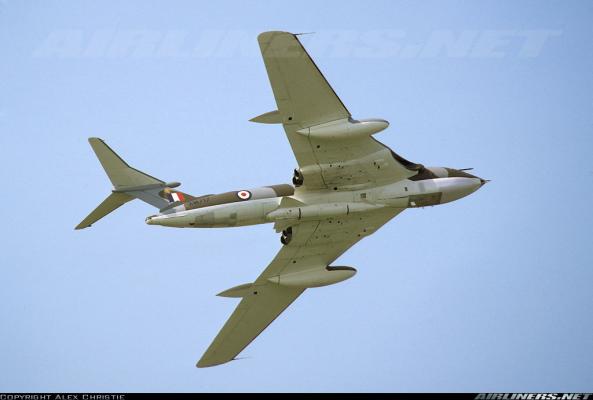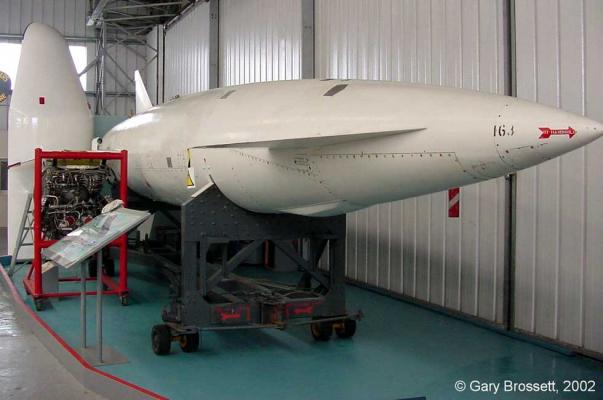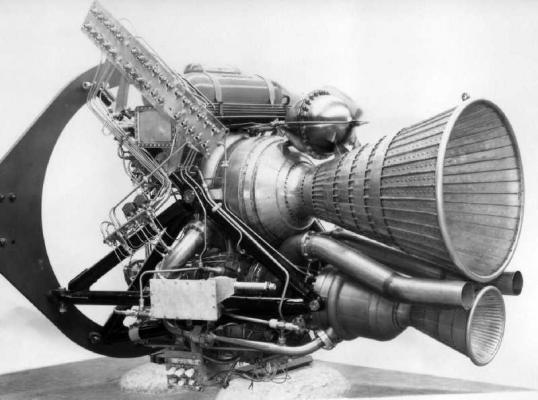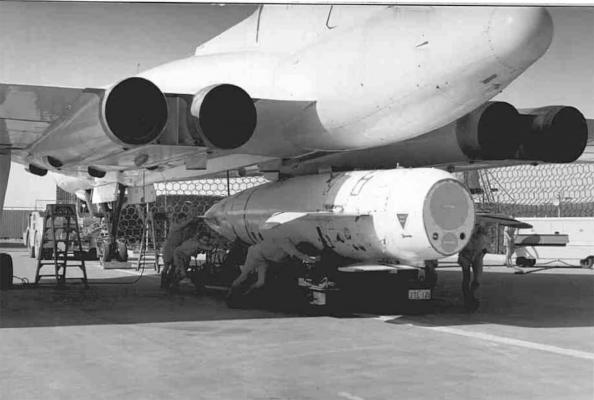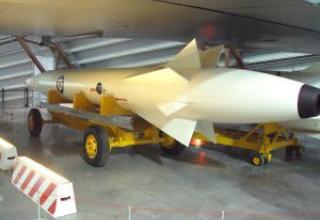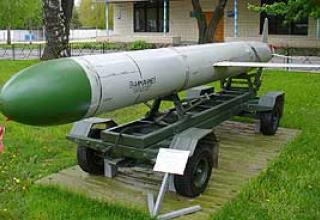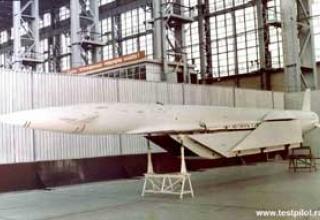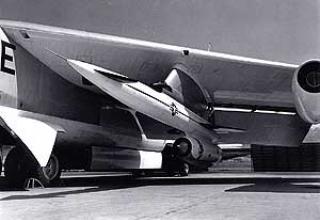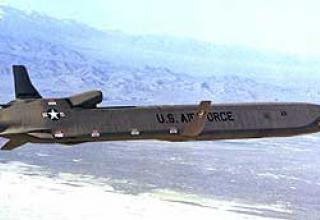In November 1954, the United Kingdom Department of Supply issued a memorandum stressing that by the end of the 1950s, the capabilities of the USSR air defence system were projected to increase to such an extent that attempts by British long-range bombers to break through to their main targets in order to engage their free-falling thermonuclear bombs would be doomed to failure. To solve this problem it was proposed to develop a cruise missile with a powerful thermonuclear warhead, which could be used either to directly hit the target or to neutralize important air defense facilities with further penetration to the target and destruction of its bombs. The firing range of the new missile was to be at least 90 km.
The requirements for new weapons by the Air Force were specified in September 1954 following the release of Operational Requirement OR.1132. Among the requirements were: a maximum speed of the order of M = 3, a compact and powerful thermonuclear BC, the possibility of using the missile all three types of British long-range bombers class V (Valiant, Victor, Vulcan). In 1955, the Department of Supply announced the lead contractor for the development of a new missile - it became the Weapons Research Division of A.V. Roe & Co Ltd, better known as Avro. The competitor's variant, Vickers Armstrong, was rejected. Subcontractors were chosen: the development of the control system - Elliots (Elliot Brothers Ltd.) in conjunction with the Royal Aircraft Establishment (Farnborough) with the assistance of Kearfott (USA), the creation of the power plant - the Power Division of British engine builders Bristol Siddeley, the design of auxiliary onboard power supply, as well as the main power plant for the prototypes was engaged in the Guided Missile Division of de Havilland. The thermonuclear warhead was traditionally developed in the UK by the Aldermaston Atomic Weapons Research Establishment under Operational Requirement OR.1141 (codenamed Green Bamboo). During the course of the project, Avro envisaged further development of the concept of a new missile called Blue Steel. The choice of two parts (Blue + Steel) of the code designation of the project was made from special lists (so-called Rainbow Codes) of the Ministry of Supply at random in order to ensure secrecy, ie generally speaking, the name Blue Steel itself does not carry any particular semantic load. Modifications were designed to achieve longer maximum range (up to 1700 km) and higher maximum speed (up to M=4.5), but all these ideas were never realized, both for technical and financial reasons.
The direct development of the missile began in March 1956, after signing the contract with the lead contractor. The creation of the new weapon was accompanied by numerous problems. One of the most significant obstacles faced by the developers, was the inability to quickly assess the mass dimensional parameters of a promising thermonuclear warhead, which had an extremely detrimental effect on the assessment of possible characteristics of the missile itself - the inability to create a proper British thermonuclear warhead led to a delay in the creation of the missile for a period of 2 to 3 years. In 1957 the Green Bamboo BC was no longer considered a standard for the new SLCM - by 1958, scientists and engineers were already developing BC for the SLCM based on the Granite device. An important problem was the problem of selecting suitable structural materials to create the proper means of delivery for this BC. Difficulties were also encountered in creating its inertial navigation system - it was not possible to achieve acceptable accuracy and reliability. The developers also faced significant system problems in integrating all weapon systems into a single whole.
It is estimated by British scientists and engineers that it would not be possible to create a prototype of a suitable thermonuclear BC in-house before 1958, which could have a detrimental effect on the programme as a whole. The advent of a full-fledged serial BC would take several more years. Due to the circumstances, in November 1958 it was finally decided to cancel OR.1141 and to purchase a license for the production of thermonuclear BC W-28, originally intended for the American ALCM Hound Dog, from the United States under OR.1171. The changes made by the British in the American development were minimal and concerned primarily the use of their own design materials and safety options. This choice of BC was influenced by the assessments of specialists from AWRE, from whose researches an unambiguous conclusion was made - the prospective "national" BC will be larger and heavier than the "English" W-28, which was named Red Snow. In addition to the Blue Steel missile, the new BC was used on the free-falling thermonuclear bomb Yellow Sun Mk2. After determining the mass dimensional parameters of the BC work on the missile sharply accelerated.
The first mass scale models (designation W102) of the new ALCM were manufactured to a scale of 2/5 of the original and used since 1957 for drop tests over the area of the Cardigan Bay range in Wales. Mock-up throws were made from aboard Valiant and Vulcan bombers. The first batch of 6 large-scale models was subcontracted by Air Service Training from light alloys. Later, according to the results of the first stage of testing, it was decided to start manufacturing and launching of 2/3 scale models (designation W103), already equipped with RDTT and autopilot with Elliots prototype INS. After the flight program was completed, they self-liquidated. Then, a model (designation W103A) was developed, equipped with a parachute to save it after it was dropped from the carrier, an advanced prototype of the INS and the Havilland Double Spectre (according to some reports, due to unpreparedness of this Double Spectre, RDTT was also used first). These prototypes were made of aluminium alloys due to problems with the production of the required stainless steels. By the end of 1959 their testing was mostly completed. In the course of these tests the aerodynamic characteristics of layouts, operation of control system and LCD, integration with carriers were checked.
By this time, testing on the Cardigan Bay Range had ceased due to its limited size and capabilities. All further tests, including firing at maximum range, it was decided to move to Australia (a member country of the British Commonwealth), to the Woomera Missile Range, preliminary preparation for the new weapon testing began in 1956. Storage and preparation of missiles was held there, based on the so-called Weapons Research Establishment (Salisbury). To support the tests in 1957 at the Avro plant in Woodford was formed the 4th Joint Test Service Unit. It was a mixed unit of UK Air Force and civilian organisations including RAE and Avro, while Elliots, EMI, Handley Page, Hunting and the Weapons Research Establishment joined the project later, at different times. The first commander of the unit was Lieutenant Colonel Underwood, until he was replaced by Lieutenant Colonel Fennel in January 1964. The aircraft assigned to the group were Vulcan B.2 and Victor B.2; Vulcan B.1 was used occasionally.
Test planning in Australia and the preparation of equipment for the site were developed during three British field missions between 1956 and 1957. The objectives of the preliminary tests were to investigate problems related to aerodynamic stability, control and kinetic heating at supersonic speeds. Large-scale models would also be sufficient for these studies, according to experts. However, since Blue Steel was an airborne launch vehicle, its tests had a "complicating factor" for the launch vehicle, so all three types of "Series V" bombers - the alleged carriers of the new missile - had to take part in the tests at different times. The first group of specialists, the Valiant bomber and the W102 mock-up arrived in Australia directly for testing in July 1957. Subsequent departures were initially planned to continue one per month, but the next mock-up (series W103A) was launched only in February 1958. By this time the model received a solid fuel engine with a burning time of 25 seconds, which allowed to provide a range of about 60 km from the point of discharge above the range. The prototype had two telemetry sensors, and the Valiant bomber was equipped with cameras in the bombshell and on the wing tips to photograph the starting point. This was Australia's first "Blue Steel" flight with an engine and it ended in a very promising way: the engine and control system worked well and the missile, after completing the main flight program, dropped smoothly by parachute into the assembly area of the test equipment.
Until the end of 1958, 5 more models were launched. From 6 launches of the program in 1958 only half of them were recognized as successful. By that time, the experimental base of the range had undergone a serious upgrade, which helped to relatively successfully fulfill the program of launches in 1959 - out of 9 launched prototypes of the W103A prototype series only 2 did not perform the flight program. It was decided not to arm the new Valiant bombers, as the latter were to be converted into air tankers for refueling Victor and Vulcan bombers. Actually Blue Steel was planned as a temporary phenomenon, until the entry into service of British long-range bombers promising U.S. missile Skybolt.
In 1959, after the selection of BC brand, for tests prepared a model of a new series (designation W100), full-size, made of stainless steel and equipped with a Stentor LCD. The following year, the products of the W100A series were produced, equipped with the first samples of the standard INS. Due to the ongoing modernization of the technical base of the range and the fact that the appearance of carrier aircraft Victor and Vulcan was expected at the range, the testing program in 1960 was, in fact, frustrated - by the end of the year there were only two launches of W102 models to test new carriers and facilities of the range. A total of 60 full-scale mock-ups and serial missiles were planned to be launched before they were put into service. The launches began on February 22, 1961 and by the end of the year their number had reached 14, including both models of new series and serial missiles Blue Steel Mk1, designated W105. The total number of fully successful launches in 1961 did not exceed 5. In 1962 the situation slightly improved - out of 15 launches completely successful, according to British data, were "about half".
However, in September 1962, the missile was recognized by the Royal Air Force as "suitable for the task", after which serial copies began to arrive in service units. And in October 1962, British long-range bombers Vulcan B.2A (there was also the designation B.2 (BS)) have already begun to carry out an experimental - combat duty with new weapons on board. In February 1963, the first Vulcan bomber unit officially reached full operational capability. Given the low reliability of the new missile, we can assume that this decision was purely political, demonstrative: in late December 1962, the U.S. closed the Skybolt program, which was a shock to the British military and politicians. As a compensation, the US offered to provide Britain with large-scale scientific and technical assistance in developing its own maritime strategic nuclear forces, but these plans could be implemented at the maximum tension of all national forces not earlier than the late 1960s, which made long-range bombers with the Blue Steel ALCM the only national means of so-called "nuclear deterrence" for a relatively long period.
Taking into account the current situation in the field of national nuclear weapons, British scientists and engineers from the very beginning proposed a program of gradual deep upgrading of the Blue Steel missile, which was to gradually get more powerful BC, longer range, higher speed, etc. However, since the most significant part of the funding of the United Kingdom's Department of Defense was spent on financing the development of the nuclear missile submarine fleet and infrastructure, there are practically no funds left to finance Blue Steel modernization programs. The only modification of the original version was the Blue Steel Mk1A ALCM (Blue Steel Low Level Project, designated W105A), which was able to be launched at low altitudes - by the end of the first half of the 1960s, the British military, following the example of their U.S. counterparts, concluded that only the "withdrawal" of bombers from the stratosphere at low altitudes when overcoming the air defense system can increase the probability of "breakthrough" aircraft to potential targets. If the Mk1 ALCM modification was separated from the carrier at an altitude of 15.2 km, then the Mk1A version of the ALCM could, according to some reports, be used from an altitude of about 150 m. All Mk1 versions of the AEC were upgraded to Mk1A. Production costs of the Mk.1A version were 0.25 million FTL (all costs of adapting the "V-series" bombers to low altitudes were 2.2 million FTL). After Blue Steel's low-altitude launches at the Australian range "proved 100% effective", the Wittering bomber wing reached initial operational capability in 1964. Missile refinements were not particularly extensive - the main difference was that the two combustion chambers were now launched and worked together. A 30-meter-long halyard was used to initiate the launch of the WRD. The launch range under such conditions was reduced to 40-80 km instead of 280 km at high altitude, and at the launch point the bomber had to increase the pitch angle to give the missile enough space to reach the altitude. After launch, the altitude was in the order of 5.2-12.2 km, where the Stentor engine was turned off and the missile diveed to a target with a theoretically achievable CWO of 275 meters. As the lower launch boundary of Blue Steel increased, the range of its flight increased slightly. Work on promising modifications of the Blue Steel ALCM (Mk1D and Mk2) was phased out by early 1960 in favor of the never implemented Skybolt program.
In September 1963, Victor B.2's long-range bombers came on combat duty with new weapons. Three Vulcan bomber squadrons based in Scampton (617th, 27th and 83rd) and two Victor bomber squadrons at Wittering Air Base (100th and 139th) were added to the new ALCMs. Testing in Australia, meanwhile, went ahead - in 1963, 14 missiles were tested, 2 of them in the Blue Steel Mk1A version. According to published British data, all launches were "fully or partially successful". Further, only W105A missiles participated in flight tests, and all previously manufactured W105s were upgraded to W105A. By this time, weapons and equipment testing (without launches) involved in the so-called Blue Ranger operation and bombers of combat units - flying from the ALCM on external sling from their bases to Australia and back (sometimes through the U.S.).
In general, the testing of new weapons over the Australian range, although it sometimes presented a lot of surprises to the technical staff and required considerable effort, still did not do without tragic accidents. The only serious incident that nearly cost the life of the crew of a Victor bomber with Blue Steel on board occurred on August 17, 1962 (see memoirs of John Saxon, a direct participant in the incident).
All 5 units equipped with bombers and new ALCMs reached full operational capability only in 1964. In March of the same year the flight tests of the missile were completed - after 3 launches of W105A series products (1 of them failed) it was decided to start the finishing and acceptance tests, in which 11 more missiles were fired on different trajectories until October 1964, all "fully or partially successful". These were the last test launches of this ALCM. Then, in January 1965, the test program was shut down by the Labor government with the preservation of the site - it was envisaged that it could resume operations with this AESC until the end of 1965. According to some reports, 49 W105/W105A series missiles were launched during the tests, of which only 25, or 51 percent, were fully successful, demonstrating the low reliability of the new weapon. According to published materials, each serial missile was worth "more than 1 million pounds".
Originally it was planned to rearm six squadrons - three with Vulcan bombers and three with Victor - with a new missile, but delays in upgrading the latter to version B.2R led to the fact that on February 10, 1964 the third squadron of Handley Page bombers was reoriented primarily on intelligence tasks. In total, 21 Victor missiles were upgraded to the B.2R version. It should also be noted that the orientation of the British military on the promising American missile Skybolt has dealt a serious blow to the welfare of the Handley Page company. Based on the fact that each Vulcan could carry two U.S. missiles without the need for serious modifications and solving the problem with the small sub-body space of the carrier bomber, it was considered quite justified, without affecting the combat effectiveness of the bomber aviation command, "cut" the order for Victor bombers option B.2 from 57 to 32 pieces. The price of this decision was the projected savings of 14 million pounds in 1960-1965.
The contract for mass production of missiles from December 15, 1960 provided for the production of 75 copies, but later the order was reduced to 57 missiles in regular equipment (designation W105/W105A), which was enough to equip 48 bombers - each aircraft carried on the external sling under the fuselage of one SLCM. At least one bomber in each bomber squadron was maintained on constant ground combat duty. In addition, this number of ALCMs made it possible to guarantee the availability of a certain reserve in the so-called "operational reserve". For training purposes, the United Kingdom Air Force received 16 W103A missiles in the training package (without tanks, LRBMs and BC, but with a full SC) and a number of products designated W100A, suitable for launch, and intended, in British terminology, "for familiarization purposes.
At the same time, the value of these weapons as a means of carrying out combat duty and keeping nuclear deterrence forces on constant alert cannot but be questioned. When a Blue Steel aircraft was on ground combat duty, no hydrogen peroxide was poured into the suspended missile for security reasons. From the moment the take-off order was received, at least 1.5 hours had to pass to refuel it and perform other necessary procedures. Such precautions could only be lifted in the event of national alarm (this level of preparedness in the United Kingdom was introduced only once, during the 1962 Caribbean crisis). That is, in the event of a surprise nuclear attack, the main armament of the British Air Force Bombardment Command would be simply undetected! It is worth noting, however, that with the increased readiness of the United Kingdom's strategic nuclear forces, the number of bombers of each squadron on combat duty doubled. On high alert, bombers from the ALCM could be launched into the air 15 minutes after receiving a command. Repeated exercises were conducted for the withdrawal of combat-ready forces from a nuclear strike with ensuring the highest readiness, i.e., combat duty of crews right in the cockpits of fully prepared for take-off bombers from the ALCM on the external sling - in this case the take-off into the air was possible less than 2 minutes after receiving the command.
However, despite all the shortcomings of the new weapons, as of the mid 1960s the Blue Steel APC was the best that the British industry could offer its armed forces. Therefore, after the end of the transition period associated with the development of the missile in operating units, the Bombardment Command decided to launch Blue Steel training and combat operations by the crews of the Command. In addition to verifying the skills of flight and maintenance personnel in the maintenance and use of new weapons, these launches of mass-produced items were intended to confirm the validity of the technical solutions implemented under the plan to build up the missile systems and the complex. They were planned to be conducted near the British Isles from different launch vehicle heights and at different ranges (below maximum). For these purposes in the period 1966 - 1967 it was decided to use 4 serial missiles W105A in inert equipment - 2 each with Victor and Vulcan bombers, respectively. They were carried by bombers of different squadrons. The entire program was code-named Operation Fresno, and the first launch was made from the Victor carrier on May 27, 1966 over the Aberporth range in Wales, the next on August 26 of the same year also from the Victor launch vehicle. The remaining two missiles from among the allocated for the program were already fired from Vulcan launchers on May 31 and July 7, 1967, respectively. According to the published data, all these launches were successful - the launch vehicle systems and the ALCMs were operating in normal mode. At the same time, as far as it is known, in two of the four cases the actual SLCM exceeded the maximum design value up to 1.5 times - however, taking into account the high power of the standard thermonuclear BC it was considered an acceptable value. Operation Fresno launches were, according to published data, the last cases of Blue Steel ALCM deployments.
The ALCM Blue Steel began to be withdrawn from service in 1968, after SSBNs of the Resolution Class began to be delivered to the Royal Navy from Polaris-A3T SLBMs. By the end of December 1968, squadrons equipped with Victor bombers were no longer on combat duty with these SSBNs and were then converted to air tankers. The process of de-alerting the squadrons equipped with Vulcan bombers began in June 1969 and was completed by the end of December 1969. The Blue Steel was finally written off on 31 December 1970, when the Royal Navy took over the role of the national strategic nuclear deterrent force in its entirety and Vulcan bombers of the Royal Air Force returned to the "philosophy" of using only free-falling thermonuclear bombs in the event of a conflict on the European TVD.
Evaluating the Blue Steel ALCM, the British managed to create weapons that slightly increased the probability that bombers would break through the air defense system of a likely enemy, but the new missile became obsolete long before it was removed from service. Separately, it should be noted that in the second half of the 1950s, the level of British industry - once the strongest in the world - fell so much that the creation of individual new weapons by their own forces without the help of the United States has become impossible.
It is of some interest to try to compare Blue Steel with another famous AEC of that time - the American Hound Dog. First of all, it is noteworthy that there is a significant difference in the number of mass-produced missiles - American missiles were manufactured more than an order of magnitude (!) More. Because of the difference in design approaches (in particular, the use of TRD, which is noticeably more economical than LRBM), the U.S. missile had a longer range. Hound Dog had an undoubted advantage in terms of performance compared to Blue Steel - for example, the ability to carry a long combat duty in a state of high alert, including in the air. The U.S. missile had a much larger set of flight paths than the British missile, which allowed for better survivability in combat conditions. In addition, a couple of missiles could be loaded on board each Hound Dog carrier, not counting free-falling thermonuclear bombs and cruise missiles - traps, which provided greater flexibility of application and was advantageous compared to British reality, where the carrier could take on board only one SLCM Blue Steel. At equal BC power, the theoretically achievable CWO of a British missile was much smaller, but the launch results often made practical accuracy much worse and close to the corresponding value for a U.S. missile for some missile applications. However, at higher maximum flight altitudes, Blue Steel's speed was noticeably higher than that of the Hound Dog, which, combined with the lower EPR value of the missile, made it more difficult for the missile to be intercepted by air defense systems of the time.
Composition:
The Blue Steel cruise missile was made according to the aerodynamic scheme "duck" (see the scheme). Various stainless steel grades were mainly used as construction materials. In its head part was a triangle-shaped rudder (in plan) with cut ends, and in the tail of the fuselage - a triangular wing with bent ends and two keels. The fuselage keel with the suspension of the rocket was folded and installed vertically after take-off of the aircraft carrier. The missile was controlled by nose rudders, ailerons and a steering wheel on the upper keel. The missile was white colored, which allowed to maintain temperature balance inside the KR hull during its flight at high supersonic speed and, if necessary, to provide protection from the thermal impact of an outbreak of nuclear explosions.
The need to place Blue Steel on Victor and Vulcan carriers caused a number of structural changes in the armament compartments of these aircraft. For example, on the Handley Page bomber, the sashes of the bomber compartment were replaced by fairings attached to the fuselage with quick-opening locks. The fairings were tightly attached to the rocket body by means of a rubber seal. Victor was equipped with a "second line" bomb, which covered the neckline under the fairing after separation of the rocket from the carrier. This allowed the lower part of the missile carrier to acquire the shape of a conventional bomber after launching Blue Steel. It should be noted that, as a platform, the Victor posed some difficulties for ground personnel in suspending weapons - the gap between the ground and the suspended missile was only 35.6 cm. Preparing the weapons of the launch vehicle for departure required an effort of 5 persons and 30 minutes of time.
The holder for the Blue Steel ALCM (see diagram), which was located in the weapons compartment, was a lightweight coffered structure, supported by supports to the roof of the compartment. The missile was held by four forked racks in the corners of its beam holder, each with a molded surface held in the correct position relative to the missile by a special guide rod. All support systems required for the weapon (heating, cooling, electrical communications) passed through the beam holder.
One of the main modifications made in order to adapt the Vulcan carrier fuselage structure to Blue Steel transportation was the so-called "200 modification" - a semicircular notch at the bottom of the front and rear spars. Most of the aircraft were already under construction with such changes, the same ones that entered the army earlier, upgraded accordingly in units.
Since Blue Steel was designed for the "V Series" bombers, a single interface was created that would combine the drop mechanism, hydraulics, power, cooling and heating, and of course, the source of difficulty for the entire program - the plug systems for monitoring the ALCM condition, data collection and functioning of the drop halyard (Blue Steel Low Level). They consisted of 157 surface-to-surface pins instead of pins, which provided a smooth disconnect at launch. Although the contacts in landfill conditions generally worked smoothly, the situation was often quite different when used in squadrons, and frustrated gunners would walk from plane to plane trying to find a couple of "bomber missiles" that could interact properly.
The tail of the missile was a liquid rocket engine Armstrong Siddeley Stentor Mk101 (also known as Bristol Siddeley BSSt.1 Stentor). The engine had two fixed chambers, the upper and lower (see diagram). The upper (large) chamber, along with the lower (small) chamber, was first designed to accelerate the BSS to its maximum speed with a fixed thrust. Then, the upper chamber was turned off and only the lower chamber (small chamber) with the lower thrust but longer operating time continued. The described procedure corresponds to the low-altitude start-up mode; in the high-altitude start-up mode, the chambers were activated in series in the order "big-small". The thrust of the small chamber varied depending on the flight conditions, maintaining the ALCM speed at the same level. The upper chamber maintained traction with an accuracy of ±5%, and the lower chamber with an accuracy of ±2.5%. Fuel components - rocket kerosene RP-1 (fuel, volume of 302.8 liters) and HTP (High Test Peroxide, oxidizer, volume of 1514.2 liters) - were placed in separate tanks.
The power plant used a turbo-pump system to supply fuel components from tanks without afterburning gas generator. The turbine pumping unit operated on products of catalytic decomposition of hydrogen peroxide specially selected for this purpose from the oxidizer line in the main operation mode. The TNA was also started with hydrogen peroxide supplied to the catalytic steam generator from a separate starting tank for subsequent decomposition using nitrogen under pressure. The rocket's auxiliary on-board power source, which operated the rocket's hydraulic system, also operated on products of catalytic hydrogen peroxide decomposition. Nozzles were cooled by circulation of an oxidizer through channels molded in nozzle bodies. Nitrogen tank inflation system from the cylinder system maintained the pressure in the fuel tanks necessary for cavitation-free operation of the pumps.
Taking into account the test runs of each engine after manufacture, provision was made:
- Blowing the combustion chamber nozzles with compressed nitrogen before and after each start of the LCD,
- Blowing all hydrogen peroxide circulation circuits with heated air.
Usually the rocket was suspended from the aircraft in a partially filled condition (without hydrogen peroxide and compressed gases). Filling the rocket, suspended to the aircraft, hydrogen peroxide and compressed gases was carried out by maintenance personnel in protective suits and took about 1.5 hours, along with other necessary procedures (see photo). Such precautions could only be cancelled in the event of a national alarm. In order to prevent foreign objects from entering, up to the moment of starting the nozzle, the LCDs were closed with light covers, which were removed by the engine jet stream.
The missile was equipped with an analogue inertial control system INS Mk.1 developed by Elliots in cooperation with the Royal Aircraft Establishment with the assistance of American Kearfott, as well as an on-board Flight Rules Computer (Avro) and autopilot (development also Avro). An interesting feature of Blue Steel was the fact that its INS was much more accurate than the navigation and bomber bomber system itself! Therefore, the aircraft equipped with this missile used data from its INS, which actually served as the main source of navigation data.
Together with other elements of navigation and bomber bomber equipment "series V" INS Mk.1 formed a single sighting and navigation system. It consisted of Green Satin DISS, Ground Position Indicator, NBC navigation and bomber-computer and H2S Mk.9 sighting radar. Green Satin Doppler radar was intended for use in the range of altitudes from 80 to 18000 meters, its task was to continuously display the track speed and drift angle of the carrier aircraft. Data from the DISS were fed into the GPI, which was essentially an electromechanical calculator whose rotating counters showed the current coordinates of the aircraft (latitude and longitude). The accuracy of determination of coordinates by the DISS-GPI bundle reached 3.2 km along the route and 13 - 19 km of lateral inclination along the route for every 1600 km of the route. For periodical correction of coordinates, H2S radar was used and data from it were received by AEI's NBC Mk.2 calculator. Given the period of its development, the calculator was quite advanced for those times a small electromechanical device that constantly calculated the course, travel speed, latitude and longitude of the aircraft - the carrier.
Preparation of elements of the sighting and navigation system and check the INS of the missile itself were quite complex procedure that required the intervention of qualified specialists and took some time. Particular attention was paid to the coordinated and synchronous operation of all components of the target equipment of the carrier with the rocket on board, as this was the key to the successful completion of the mission.
One member of the Woomer test site team, Technician David "Gingge" Booth, noted the complexity of pre-flight preparation of navigation equipment: "When refueling was over and power was supplied to the aircraft, the three of us climbed aboard and checked the navigation and bombing system, Green Satin DISS, Mk.1 INS and Military Flight System (MFS). Then we were ready for the pre-flight inspection, which usually took about 35 minutes. It was always done before the test run or the launch of Blue Steel.
Originally, it took me up to 8 hours to process an Elliott Bros. checklist printed on funny brown paper. With John Topless' approval, I rewrote the list using key words or phrases. After several rewrites and the use of separate words such as "INSTALL, ZAFIXIZE, and FIRST" as part of the description of the switching procedure during the check, I reduced the control card to 2 A4 sheets. Thirty-five minutes was a much better time than the 8 hours that had gone before. By the end of the test, the distribution of synchronized data between the NRS, Navigation and Bombardment System, Green Satin and MFS was recorded. Once the systems were integrated, all that was required was a long observation period in the early morning. The control unit of the inertial navigation system installed at the navigator's workplace showed, among other things, the system temperature.
The withdrawal of the rocket's INN, which was considered accurate enough, reached a maximum of 1 degree per hour, so that as close as possible to the Release Point Fix, the navigator operator carried out the final correction (Release Point Fix) to provide its onboard computer with accurate information about the aircraft's position, course, air speed, altitude, acceleration and spatial position, as well as the relative position of the target. The ship's commander would then press a button to unfold the lower keel of the missile and it would be dropped from a height of about 15 kilometres, according to one of the applications. Within 4 seconds, Blue Steel was to be in a free fall, "sinking" and planning to a distance of about 90 meters from the carrier, then launched its engine Stentor. After two seconds, the ALCM controls were unlocked and it gained speed, reaching a programmed flight altitude of about 21.6 km and a speed of M=3. The missile came under the control of an on-board IC that monitored every change in speed and direction of flight using highly sensitive instruments. The flight direction control was based on the so-called "longitudinal-transverse principle", by which each turn was started by tilting the hull using inner ailerons located at the rear of the delta wing, and was supported by increasing the lifting force on a small delta-shaped front plumage. The INS controlled the holding of a certain dive angle to the target when the missile approached it after about a 6-minute flight (typical range at an altitude launch of about 280 kilometers), airborne detonation of the BC was performed by barometers at a speed of KR M=1.5-1.8 at a low altitude above the target (see the trajectory diagram). During the low-altitude launch, the missile was dropped at an altitude of about 150 m, planning to a height of about 120 m, after which the halyard was separated and thus a command was given to launch both LRD cameras at once. After unlocking the ALCM controls, the ALCM reached an altitude of 5.2-12.2 km at a maximum speed of up to M=2.5, reaching a target at a range of 40 to 80 km after 2 minutes of flight (see trajectory diagram).
In Australia, conditional targets within the 100-yard circle (about 91 m) were regularly affected by tests. It is estimated that a conditional missile launched over London could deliver its payload to Manchester from the CWO 700 yards (640 m). In 1963, BAC Commander Air Marshal Sir John Grundy said: "Of our ten recent launches at Woomer, nine were fully successful. Blue Steel can stand up to any other missile system made anywhere.
If the Blue Steel INS couldn't be launched on the ground (e.g., a nationwide alert situation), its display was already in the air from the carrier's navigation equipment, the accuracy of the firing would then be reduced.
In the standard mode of application a few kilometers before the target the missile began to dive with further defeat of the target with an inseparable thermonuclear BC. The Red Snow BC itself was a modification of the American W-28 BC. The BC power was 1.1 Mt, which was enough to destroy weakly protected surface targets, as well as to disrupt the radar air defense systems and various radio electronics. BC was developed by the Aldermaston Atomic Weapons Research Establishment with scientific and technical assistance from the Atomic Energy Commission (USA). The round deviation of the missile at maximum range did not exceed 600 m. In the case of hostilities, the possibility of using an unguided ALCM as a free-falling thermonuclear aircraft bomb in the absence of time for refuelling the missile was considered. The same was intended to be done in other circumstances if CD malfunctions prevented its routine use.
Characteristics:
| Mass-size characteristics | |
| Weight in gear, kg | 7270 |
| Length assembled, m | 10.7 |
| Fuselage diameter, m. | 1.27 |
| Wingspan, m | 4.0 |
| Engine | |
| Type | dual-chamber LCD |
| Model | Stentor Mk101 |
| Traction, kg: - upper chamber - lower chamber |
11431 454-2812 |
| Fighting unit | |
| Type | thermonuclear |
| Charging designator | Red Snow (OR.1171) |
| Weight BC, kg | 771 |
| BC power, Mt. | 1.1 |
| Characteristics of Warfare | |
| The flight range is maximum, km: - high-altitude launch - low-altitude launch |
280 80 |
| Circular probable deviation, m: - high-altitude launch - low-altitude launch |
600 275 |
| Speed maximum, M: - high-altitude launch - low-altitude launch |
3.0 2.5 |
| The flight height is maximum, km: - high-altitude launch - low-altitude launch |
21.6 12.2 |
| Launch altitude minimum, km: - high-altitude launch - low-altitude launch |
15.2 0.15 |
Testing:
The Blowpipe complex was used during the Anglo-Argentine conflict over the Falkland Islands, on both sides. On May 21, 1982, during the landing at San Carlos Bay, a detachment of 30 Argentine soldiers using man-portable air defence systems "Blowpipe" shot down 2 British landing helicopters. On the same day, a Blowpipe missile hit Lieutenant Jeffrey Glover's Harrier. The pilot ejected. The total losses of Argentina's Air Force from Blowpipe man-portable air defence systems amounted to 9 aircraft.
In spring 1986, "Blowpipe" complexes entered Afghanistan, where they were used by Afghan mujahideen, mainly to defeat armored personnel carriers. The effectiveness of the complex against aircraft, compared to man-portable air defence systems "Stinger", was not high.
Sources:
- The real meaning of the words: a pedantic glossary of British nuclear weapons / by www.mcis.soton.ac.uk & R. Moore. UK, 2004.
- The Future of Britain’s WMD / by D.Plesch. The Foreign Policy Centre, London, UK, 2006. Blue Steel and its engine // Flight, 12 august, 1960.
- Phil Butler and Tony Buttler. Avro Vulcan. Britain`s famous delta-wing V-bomber. / Aerofax. Midland publishing, 2007
- Alfred Price, Tony Blackman, Andrew Edmondson. Avro Vulcan 1952 onwards (B2 Model). Haynes Owners' Workshop Manual. / Haynes Publishing, 2010.
- Kev Darling. Avro Vulcan.Warbird Tech Series, Volume 26. / North Branch: Specialty Press Publishers and Wholesalers, 1999.
- Kev Darling. Avro Vulcan. Part 1. RAF illustrated. / A Big Bird Aviation Publication, 2007.
- Stories of life on the Blue Steel Project at WRE/RAAF Edinburgh Field (South Australia) 1957 -1965. David ‘Ginge’ BOOTH Compiler/Editor. Canberra A.C.T Australia 1999.
- Andrew Brooks. Victor Units of the Cold War. Osprey Combat aircrafts 88. / Osprey Publishing limited, 2011.
- Andrew Brooks. Vulcan Units of the Cold War. Osprey Combat aircrafts 72. / Osprey Publishing limited, 2009.
- Navigating at 50,000 and 500 feet in the 1960s / by Air Cdre Norman Bonnor, UK, 2012. Стратегические бомбардировщики и ракетоносцы зарубежных стран / В.Е. Ильин и И.В. Кудишин. Москва, АСТ Астрель, 2002.
- История авиационного вооружения / А.Б. Широкорад. Минск, Харвест, 1999.
- http://www.airpowerworld.info/aircraft-engine-manufacturers/armstrong-siddeley-stentor.htm
- http://www.spaceuk.org/bsteel/bsteel.htm
- http://www.skomer.u-net.com
- http://www.nuclearweaponarchive.org/Uk/UKArsenalDev.html
- http://www.vforcereunion.co.uk
- http://www.nationalcoldwarexhibition.org/explore/missile.cfm?missile=Blue%20Steel
- http://www.probuspontivyfr.org


